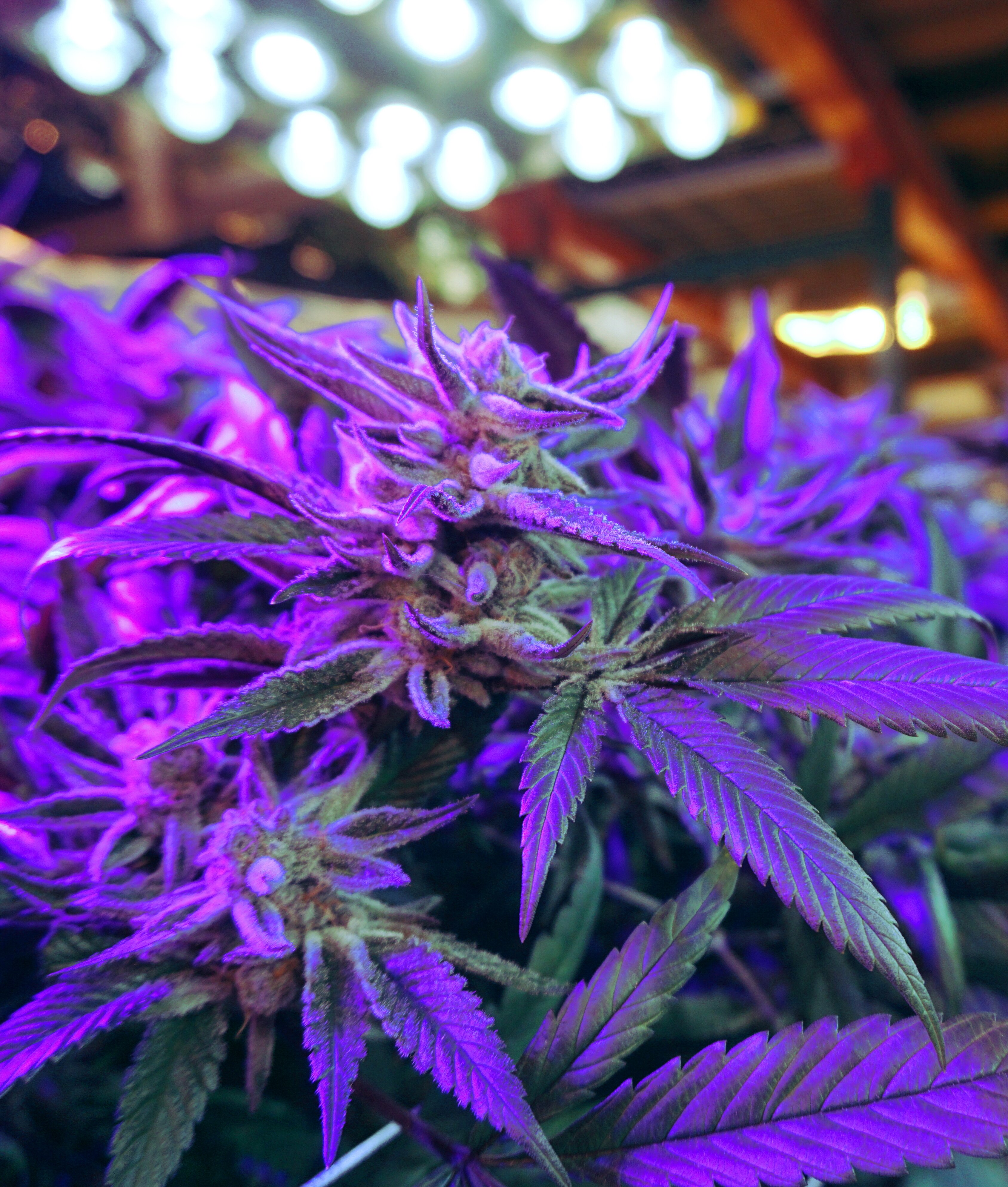Choosing the best lighting for growing cannabis can be intimidating, especially when there are so many factors to consider, like spectrum, lumens, PPFD, CRI, CCT, and more! Don’t know what those terms mean? We’ve already covered the basics of horticultural lighting, so read that first if you haven’t already. We are going to dive deeper into one of those factors, and that’s spectrum. The spectrum of light used by a plant is called photosynthetically active radiation (PAR). PAR was first defined in the 60s as the wavelengths from 400 to 700 nm. Today we now understand PAR to encompass wavelengths outside of this range, to include UV and far-red light. This article is part of a series covering all the colors of light, including UV, violet, blue, green, yellow, orange, red, and far-red light! This focus of this article will be on blue light. Blue light is radiation with wavelengths between 450 and 495 nm and it affects photosynthesis, plant height, and flowering.
Blue Light and Vegetative Growth
Blue light fits with the absorption peak of chlorophylls, which do photosynthesis to produce sugars and carbons1. Sugars and carbons are essential for plant growth, as they are the building blocks for plant cells. However, blue light is less effective than red light for driving photosynthesis. This is because blue light can be absorbed by lower-efficiency pigments like carotenoids and inactive pigments like anthocyanins2. As a result, there is a reduction of blue light energy that makes it to the chlorophyll pigments. Surprisingly, when some species are grown with just blue light, plant biomass (weight) and photosynthesis rate are similar to a plant grown with just red light3. This tells us that the importance of blue light for photosynthesis and growth is species-dependent
Although a plant can be grown using just blue light, most plants have faster growth with a broader spectrum of light. Blue light is typically used in conjunction with red light, since photosynthetic pigments more efficiently absorb red light than other regions of the spectrum. The blue-red light combination allows for a faster rate of photosynthesis than either red or blue light alone1. Compared to blue light alone, the red-blue light combination increases photosynthesis rate, leaf number, and plant size in many species, like tomato, cucumber, peppers, lettuce, and strawberry3–6. What about adding other colors of light too? The addition of green light to red-blue light further increases plant height7! At this time, the ideal ratio of red, blue, and green light (as well as other colors of light) is not yet known for many species, including cannabis. For one tomato variety, the ideal ratio is documented to be 1:2:1 for R:B:G8. Likely, the ideal spectrum for cannabis vegetative growth will be strain-dependent. For this reason, it’s important to choose a “full-spectrum” horticultural light that has high amounts of blue and red light and moderate amounts of other colors of light.
In addition to playing an important role in photosynthesis, blue light is well known to suppresses stem elongation (“stretching” or etiolation)9. Stem elongation occurs when a plant is receiving insufficient light and it stretches up to capture more light. Plants grown with blue light are usually shorter and have thicker, and denser leaves compared to plants grown without blue light10. This is attributed to the action of chryptochrome, which responds to blue light to control several aspects of plant growth and development, including stem elongation.
It’s clear that blue light is important for vegetative growth. The addition of red light and other colors of light further increase photosynthesis rate and plant size. At this time, the ideal ratio of each of these colors of light is unknown. Likely, the ideal spectrum for vegetative growth will be species- and strain-dependent. For this reason, it’s important to choose a “full-spectrum” horticultural light that has high amounts of blue and red light and moderate amounts of other colors of light.

Blue Light and Flowering
When it comes to growing cannabis, many cultivators are most interested in the quality of light used for the flowering stage. Blue light can regulate flowering in a number of ways, such as increasing bud size, and regulating the timing of flowering. The flowering process is resource-intensive, and there is a strong positive correlation between plant size (i.e., vegetative growth) and bud size. A plant with high photosynthetic rates will accumulate more resources that later allow it to produce large, dense flowers. Thus, in order to have a high yield, it is essential that a cannabis plant is provided with high amounts of PAR during the vegetative stage. As described above, blue light is essential for achieving high rates of photosynthesis that translates to high yields.
In addition to controlling bud size, a cultivator may wish to control flowering time. Through the action of chryptochrome, blue light is a strong regulator of flowering time. In long-day plants, blue light can promote flowering, and in short-day plants, it can inhibit flowering. For example, in mustard, a long-day plant, blue light accelerates flower initiation by 20 days compared to plants grown without blue light11. At the time of writing this article, the effect of blue light on cannabis flowering is not yet know. Cannabis is a long-day plant, and increased amounts of blue light are predicted to induce flowering. Until additional studies are performed, it is recommended to use a “full-spectrum” horticultural light that includes high amounts of blue light, as well as other colors of light.
Blue light is essential for both the vegetative and flowering stages of plant growth. Blue light should be used in conjunction with red light to increase photosynthesis and plant size. The addition of other colors of light, such as green, has been shown to have further benefits for plant growth. For this reason, “full-spectrum” lights usually produce better results that mono-colored or dual-colored lights. Blue light is a strong regulator of plant height and flowering. Generally, blue light makes plants more compact by making stems shorter and thicker. In long-day plants, like Cannabis, blue light can promote flowering.
- Darko, E. et al. Photosynthesis under artificial light: the shift in primary and secondary metabolism. Philos. Trans. R. Soc. B Biol. Sci. 369 (2014).
- Cope, K. R., Snowden, M. C. & Bugbee, B. Photobiological interactions of blue light and photosynthetic photon flux: Effects of monochromatic and broad-spectrum light sources. Photochem. Photobiol. 90, 574–584 (2014).
- Shimizu, H. et al. Light environment optimization for lettuce growth in plant factory. IFAC Proceedings Volumes (IFAC-PapersOnline) 18, (2011).
- Ouzounis, T. et al. Blue and red LED lighting effects on plant biomass, stomatal conductance, and metabolite content in nine tomato genotypes. Proc. VIII Int. Symp. Light Hortic. 8, (2016).
- Naznin, M. T., Lefsrud, M., Gravel, V. & Hao, X. Using different ratios of red and blue LEDs to improve the growth of strawberry plants. Proc. VIII Int. Symp. Light Hortic. 8, 125–130 (2016).
- Li, Q. & Kubota, C. Effects of supplemental light quality on growth and phytochemicals of baby leaf lettuce. Agric. Food Sci. 67, 59–64 (2009).
- Wang, Y. & Folta, K. M. Contributions of green light to plant growth and development. Am. J. Bot. 100, 70–78 (2013).
- Lu, N. et al. Effects of Supplemental Lighting with Light-Emitting Diodes (LEDs) on Tomato Yield and Quality of Single-Truss Tomato Plants Grown at High Planting Density. Environ. Control Biol. 50, 63–74 (2012).
- Olschowski, S. et al. Effects of red, blue, and white LED irradiation on root and shoot development of Calibrachoa cuttings in comparison to high pressure sodium lamps. Proc. VIII Int. Symp. Light Hortic. 8, (2016).
- Massa, G. D. et al. Plant productivity in response to LED lighting. HortScience 43, 1951–1956 (2008).
- Eskins, K. Light-quality effects on Arabidopsis development. Red, blue and far-red regulation of flowering and morphology. Physiol. Plant. 86, 439–444 (1992).

Dr. Vanessa Nielsen completed her Ph.D. at the University of Toronto, Canada in plant biology and physiology. She uses this background and fascination with novel lighting technologies to research the impact of light on plant yield at URSA Lighting. Her background and extensive experience in a plant biotechnology lab offers a unique perspective on lighting for the cannabis industry. Vanessa is always happy to share the best industry practice in cannabis growth and the latest discoveries of how to optimize lighting conditions for your plants.



